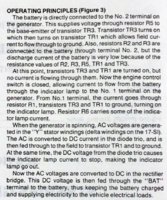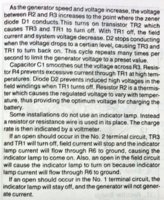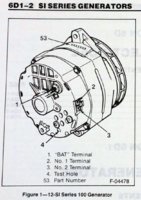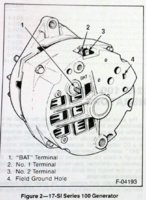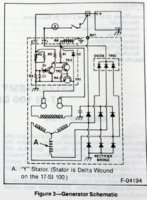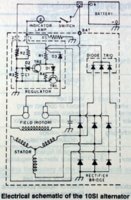In answer to my questions, I have managed to find a diagram and photos with the regulator in place on an alternator. It sits on an insulated block which contains the brushes and the fixing screw attaches a jumper lead from the regulators metal case DF to one of the brushes. The Black wire D- is grounded to the alternator body. The Yellow wire D+ attaches to the other brush where it conveniently picks up its power. As stated by DoubleE above the Red wire B+ connects to the battery.
Above: The regulator is supplied with a jumper that is attached to the metal case by the screw that secures the regulator in place on the insulated brush block. This jumper is DF and goes to the field winding.
Above: For a car, note how the jumper DF goes from the metal case fixing screw to a brush, Yellow D+ goes to the other brush and picks up power via the orange wire from the rectifier, and the Black D- wire at the top earths to the metal body of the alternator.
These photos clear everything up so I can confirm the connections for those wishing to use the Cargo 130642 (replacement for A-Type Lucas 14Tr):
Black Wire D- goes to earth.
Yellow Wire D+ is the indicator wire and should be tied to positive i.e. the brown lead supplying power from the ignition switch.
Metal Case DF is the control for the field winding and connects with the green wire from the rotor brush.
Red Wire B+ is the voltage sensor and connects to the red battery positive (strictly speaking), but an alternative routing would be to connect to the brown ignition power wire if this shows virtually no voltage difference compared with the Red battery circuit on the XS650.
The metal casing for the Cargo 130642 must be isolated from earth. If possible it would be a lot easier to use one of those regulators recommended in the US where the metal casing is grounded (D-) so it can be placed directly on the heat sink with the rectifier without making special provisions to insulate.
Thank you and I hope to place a photo tomorrow of the final product.




